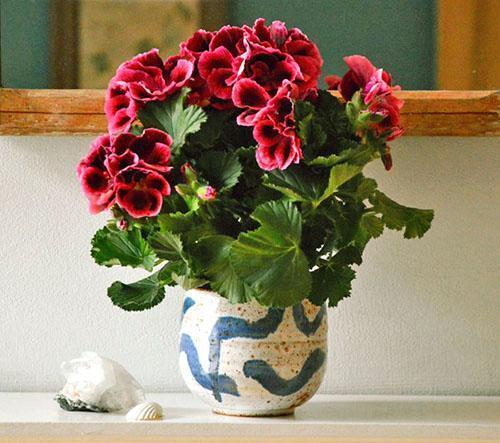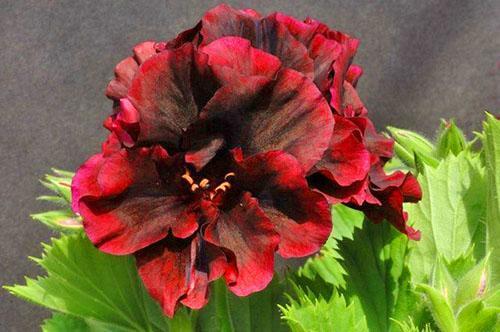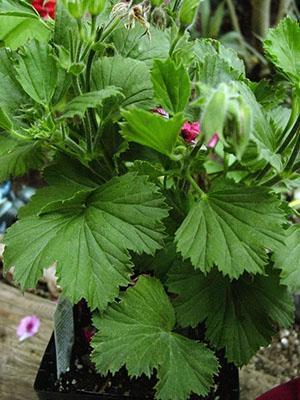Photo of royal pelargonium and plant care at home
 In the courtyard front gardens, on window sills, balconies and even on city flower beds, with the onset of summer, you can see brightly blooming bushes of pelargonium, popularly called geraniums. Due to its unpretentiousness and ease of care, pelargoniums are deservedly loved by flower growers. But, unfortunately, few people suspect that among the family of real "Cinderellas" there are also "queens".
In the courtyard front gardens, on window sills, balconies and even on city flower beds, with the onset of summer, you can see brightly blooming bushes of pelargonium, popularly called geraniums. Due to its unpretentiousness and ease of care, pelargoniums are deservedly loved by flower growers. But, unfortunately, few people suspect that among the family of real "Cinderellas" there are also "queens".
Royal pelargonium, Pelargonium grandiflorum or regale differs from its closest relatives in the most lush flowering and somewhat more whimsical character.
Features of large-flowered pelargonium

Royal pelargonium, reaching a height of 30-60 cm, differs from other varieties:
- folded leaves with a dense, rough to the touch leaf plate and jagged edges;
- large, up to 7 cm in diameter, simple and double flowers.
The decorativeness of the inflorescences is added by the multicolored color of the petals, but if the flowering period of the zonal geranium ends in the fall, then the last inflorescences on the royal pelargonium wither in the second half of summer.
As a result, it is possible to admire the caps of airy bright flowers from 3 to 5 months, and it is doubly offensive if buds do not appear on the bush in the spring.
Why does royal pelargonium not bloom?
 Having planted a young plant in the ground, amateur flower growers look forward to the appearance of spectacular inflorescences over the greenery, but sometimes they have to face disappointment. Instead of flowers, large-flowered geraniums give only greens, and fast-growing shoots soon lose their appearance and stretch out. What mistakes were made when caring for royal pelargonium at home, and why, as in the photo, the plant was left almost without flowers?
Having planted a young plant in the ground, amateur flower growers look forward to the appearance of spectacular inflorescences over the greenery, but sometimes they have to face disappointment. Instead of flowers, large-flowered geraniums give only greens, and fast-growing shoots soon lose their appearance and stretch out. What mistakes were made when caring for royal pelargonium at home, and why, as in the photo, the plant was left almost without flowers?
Indeed, if pelargonium does not bloom in due time, this may say:
- about incorrectly selected temperature conditions or lack of lighting;
- that the plant is planted in an overly voluminous pot or receives fertilizers of an inharmonious composition;
- about untimely transfer;
- about illiterate pruning or its complete absence.
How to care for royal pelargonium so that the plant blooms regularly, is healthy and does not lose its decorative effect all year round?
Summer care for royal pelargonium at home
 Speaking about the unpretentiousness of pelargonium, connoisseurs of this species are not at all cunning.
Speaking about the unpretentiousness of pelargonium, connoisseurs of this species are not at all cunning.
In order for royal pelargonium to feel comfortable and delight the owners with abundant flowering, the grower needs to adhere to just a few rules that will lay the foundation for the success of the entire cultivation.
Large-flowered varieties of Pelargonium are demanding on lighting and like to be displayed in the brightest sunny windows. Only on the hottest days do plants need a darkening protection against burns, in other cases, limiting light is a risk:
- stretching and exposing shoots;
- reducing the intensity of flowering;
- discarding already appeared buds.
 Unlike related varieties, royal pelargonium does not tolerate drafts and cold winds, if such a plant is planted in the garden, it probably will also not please with inflorescences. Therefore, royal pelargoniums are grown at home, and care in the summer includes protection from drafts. Plants thrive and bloom profusely on glazed sun terraces and loggias.
Unlike related varieties, royal pelargonium does not tolerate drafts and cold winds, if such a plant is planted in the garden, it probably will also not please with inflorescences. Therefore, royal pelargoniums are grown at home, and care in the summer includes protection from drafts. Plants thrive and bloom profusely on glazed sun terraces and loggias.
If the air is excessively dry in summer, pelargonium can be sprayed with water at room temperature, making sure that the direct rays of the sun do not fall on the wet leaves and inflorescences.
Florists who are passionate about this spectacular crop should know that in hot weather, plants are most susceptible to attacks by aphids and other pests, which, parasitizing on stems and leaves, seriously weaken pelargonium. And here is the answer to the question: "Why does royal pelargonium not bloom?" will be obvious.
 At the same time, do not forget about watering and feeding flower plants. Although pelargonium easily tolerates dry periods and is not too demanding on the composition of the soil, without water and nutrition, it will undoubtedly not produce the proper amount of flowers. In the warm season, large-flowered varieties require especially abundant watering, which is carried out when the topsoil dries out a little.
At the same time, do not forget about watering and feeding flower plants. Although pelargonium easily tolerates dry periods and is not too demanding on the composition of the soil, without water and nutrition, it will undoubtedly not produce the proper amount of flowers. In the warm season, large-flowered varieties require especially abundant watering, which is carried out when the topsoil dries out a little.
It is possible to prolong flowering and preserve the strength of a plant if dried stalks that have lost their decorative effect are removed in time.
Features of winter care for large-flowered geraniums
 After the luxurious flowers wither, pelargonium should recover, but if you leave it on a warm windowsill until next spring, you can not wait for the next flowering. How to care for pelargonium in autumn and winter? With the onset of autumn, when the temperature drops, caring for royal pelargonium at home changes. The plant is provided for three months:
After the luxurious flowers wither, pelargonium should recover, but if you leave it on a warm windowsill until next spring, you can not wait for the next flowering. How to care for pelargonium in autumn and winter? With the onset of autumn, when the temperature drops, caring for royal pelargonium at home changes. The plant is provided for three months:
- temperature of the order of 12-15 ° C;
- rare watering, only supporting the decreased activity of pelargonium;
- adequate lighting.
Top dressing for the entire wintering period is stopped. If all the conditions of care are met, the plant lays a sufficient number of flower buds and, upon coming out of the winter torpor, will surely bloom luxuriously.
Transplantation and feeding of royal pelargonium
 All types of pelargonium are distinguished by the rapid growth of the aerial part of the plant. If a bush that has grown pretty much over the summer, together with the soil removed from the pot, has roots completely entwined with an earthen ball, at the end of winter, the royal geranium is transplanted. The soil for this culture should be loose, breathable and moisture retaining. Thinking about why royal pelargonium does not bloom, the florist must take into account the correct selection of the soil mixture. A good option is a mixture of equal parts of disinfected garden soil, sand, and peat.
All types of pelargonium are distinguished by the rapid growth of the aerial part of the plant. If a bush that has grown pretty much over the summer, together with the soil removed from the pot, has roots completely entwined with an earthen ball, at the end of winter, the royal geranium is transplanted. The soil for this culture should be loose, breathable and moisture retaining. Thinking about why royal pelargonium does not bloom, the florist must take into account the correct selection of the soil mixture. A good option is a mixture of equal parts of disinfected garden soil, sand, and peat.
Since the root system of the plant does not tolerate stagnant moisture, a powerful drainage layer is required for pelargonium, no less attention is paid to the selection of the pot when planting. It is because of transplanting into too large dishes that many flower growers are disappointed in the culture, and royal pelargonium does not bloom.
Getting into a large pot, the plant rapidly grows green mass, but completely "forgets" about the set of buds.
A similar process takes place with an incorrectly selected fertilizer mixture. If nitrogen predominates in the dressing during the formation of buds and flowering, the stems and leaves grow, and the buds become less and less. The best mixtures for feeding pelargonium are characterized by a high potassium content and phosphorusproviding abundant and long-lasting flowering.
Pelargonium pruning
 The reason why royal pelargonium does not bloom may be incorrect or insufficient pruning.Since the plants grow quickly, and the buds are formed at the tops of the shoots, it is easy to increase the purely flower buds, in July and August, pinching or cutting off the tops of overgrown stems. This measure will allow:
The reason why royal pelargonium does not bloom may be incorrect or insufficient pruning.Since the plants grow quickly, and the buds are formed at the tops of the shoots, it is easy to increase the purely flower buds, in July and August, pinching or cutting off the tops of overgrown stems. This measure will allow:
- use the resulting cuttings for propagation;
- achieve lush flowering in the coming season;
- stimulate the growth of young shoots;
- give the bush a compact, attractive shape.
It is better to prune the plant gradually, without seriously injuring the pelargonium, and after the operation, the plant must be fed. At the end of winter, with the beginning of new bud formation, pruning is completed.
Pelargonium cuttings
 The resulting cuttings can be rooted all year round, but in the warm season it is much easier to do this.
The resulting cuttings can be rooted all year round, but in the warm season it is much easier to do this.
As a planting material, take strong tops of the shoots, having at least two pairs of leaves and cut 5 mm below the node. It is better to cut off the lower leaves immediately and leave no more than 3 upper leaf plates. After this, the places of the cuts on the cuttings are treated with crushed charcoal and left in the air for 18-24 hours.
However, there is another way. Already 10 minutes after separation from the mother plant, cut cuttings:
- processed with root;
- planted in a mixture of sand, humus and peat;
- cover with a nonwoven fabric for 2-3 days.
Planting cuttings in moist peat tablets gives good results.
In any case, the plantings are watered with a phytosporin solution, which will protect the sections from the development of rot. And how to care for pelargonium after the cuttings have given roots?
 It will take 8 to 12 weeks until the cuttings are well rooted at 19-23 ° C. After this time:
It will take 8 to 12 weeks until the cuttings are well rooted at 19-23 ° C. After this time:
- young plants are planted in a permanent place;
- pinch the main shoot above the third pair of leaves, which will force the bush to give new side stems.
If at home the care of royal pelargonium, as in the photo, is good, young plants develop well, and already next spring small neat bushes give the first inflorescences.